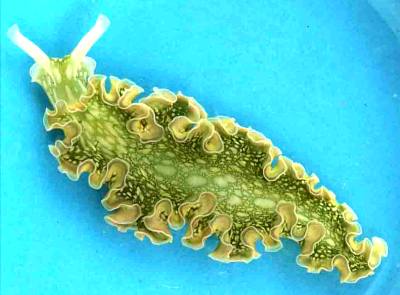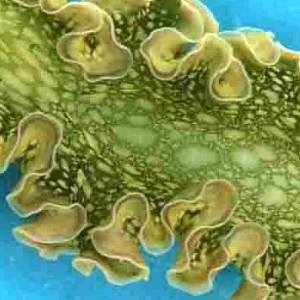Algal genes in Elysia crispata
May 2, 2003
From: Skip Pierce


Note added 30 May 2006: This is most probably Elysia clarki, a new species which was previously considered a colour form of E. crispata
NOTE: the paper referred to below is now published:
• Pierce, S.K., Massey, S.E., Hanten, J.J. &. Curtis, N.E. (2003). Horizontal Transfer of Functional Nuclear Genes Between Multicellular Organisms. Biological Bulletin, 204: 237-240.
Hi Bill
A while back you invited me to say a word about my research program. I didn't answer because we were sort of in mid experiment. You might be interested to know that, after a few years of searching, we (well, my post-doc Steve Massey and a graduate student, Nick Curtis, who get to work in the lab while I do administrative duties) have developed some pretty solid molecular evidence showing at least one gene that codes for a chloroplast protein is located in the genomic DNA of a sacoglossan slug. The paper reporting the results has been accepted and will be out in the June issue of the Biological Bulletin. As you know many species of Elysia eat particular species of coenocytic algae and certain cells that line the digestive diverticula capture large numbers of intact chloroplasts as the eaten algae passes through the gut. So many plastids are captured that the slugs are green—in fact the density of chloroplasts in the slug is often greater than in the algae. The plastids reside in the cytoplasm of the slug cell, in some species for months, continuing to photosynthesize. So, if you shine light on the slug, it fixes carbon and produces oxygen as if it were a plant. To make a long story short, continued photosynthesis requires the synthesis of certain chloroplast proteins, many of which are coded in the algal nuclear genome. We had obtained a bunch of circumstantial evidence that genes for some of the light harvesting proteins of chloroplasts from the chromophytic alga, Vaucheria litorea, were being synthesized on cytoplasmic ribosomes in Elysia chlorotica, implying that the genes were in the genomic DNA of the host cell. Since finding the genes for those particular proteins was proving problematical for a variety of reasons (lack of algal sequence data, severe lack of sequence conservation, no amino acid sequence data, etc), we began looking at other species, in particular, Elysia crispata. There are several reports in the literature about what alga this species eats, all of which are wrong, I think (we'll publish on that issue later). However, after doing a variety of experiments, which are described in the Biol. Bull. paper, we were able to locate a gene for a chloroplast protein, fucoxanthine-chlorophyll binding protein, in the E. crispata DNA. Some species of Elysia, like E. rufescens, for example, do not seem to be able to maintain the plastids for more than a few days—so you might not expect that algal genes have been transferred in them—but species like E. chlorotica, E. viridis, E. crispata among others, that keep the plastids active for months may have a variety of algal nuclear genes present in the slug DNA. If that turns out to be the case, these slugs may turn out to be important models of not only endosymbiosis, but for things like genetic therapy (although so far, NIH has shown no interest) and mechanisms of evolution. We have some ideas about the mechanism of gene transfer-but no data.
I have included an image of E. crispata that was collected in the Florida Keys, approx. 3cm long.
Skip
pierce@chuma1.cas.usf.edu
Pierce, S.K., 2003 (May 2) Algal genes in Elysia crispata. [Message in] Sea Slug Forum. Australian Museum, Sydney. Available from http://www.seaslugforum.net/find/9830Thanks Skip,
It's exciting stuff. Do you think the algal genetic material is passed on from one slug generation to the next or does it need to be implanted anew each generation?
At the mollusc course we ran earlier this year I used a couple of earlier publications you contributed to as seminar discussion papers and the whole topic of algal-slug symbiosis, and its implications, produced some of the most animated, lively, & intelligent discussion in the 2 week course.
• Green, B.J., Li, W-Y., Manhart, J.R., Fox, T.C., Summer, E.J., Kennedy, R.A., Pierce, S.K. & Rumpho, M.E. (2000) Mollusc-Algal Chloroplast Endosymbiosis. Photosynthesis, Thylakoid Protein Maintenance, and Chloroplast Gene Expression Continue for Many Months in the Absence of the Algal Nucleus. Plant Physiology, 124: 331-342.
• Hanten, J.J. and S.K. Pierce. (2001) Synthesis of several light-harvesting complex I polypeptides is blocked by cycloheximide in symbiotic chloroplasts in the sea slug, Elysia chlorotica (Gould): A case for horizontal gene transfer between alga and animal? Biological Bulletin, 201: 33-44.
Best wishes,
Bill Rudman
Related messages
-
Relationship of Elysia diomedea and E. crispata
From: Patrick Krug, October 6, 2008 -
Elysia clarki feeding practices
From: Adam D'Agosto, December 6, 2007 -
Elysia clarki and E. crispata in Florida
From: Skip Pierce, October 10, 2007 -
Re: Elysia crispata in Cozumel, Mexico
From: Skip Pierce, February 2, 2007 -
Re: Elysia crispata in Cozumel, Mexico
From: Jim Lyle, February 2, 2007 -
Re: Elysia crispata in Cozumel, Mexico
From: Sean Kearney, February 2, 2007 -
Re: Elysia crispata in Cozumel, Mexico
From: Skip Pierce, February 1, 2007 -
Elysia crispata in Cozumel, Mexico
From: Sean Kearney, January 29, 2007 -
Elysia clarki feeding references
From: Nicholas Curtis, January 29, 2007 -
Re: What's wrong with Elysia clarki?
From: Colin Redfern, September 9, 2006 -
Re: What's wrong with Elysia clarki?
From: Colin Redfern, September 9, 2006 -
Re: What's wrong with Elysia clarki?
From: Skip Pierce, September 8, 2006 -
Re: What's wrong with Elysia clarki?
From: Angel Valdes, September 7, 2006 -
Re: What's wrong with Elysia clarki?
From: Skip Pierce, September 1, 2006 -
Re: Damaged Elysia crispata
From: Nick Curtis, August 31, 2006 -
What's wrong with Elysia clarki?
From: Bill Rudman, August 30, 2006 -
Elysia diomedea & E. clarki in home aquarium?
From: Matt Pedersen, May 30, 2006 -
Elysia clarki breeding in the home aquarium
From: Matt Pedersen, May 30, 2006 -
Elysia clarki, E. diomedea and E. crispata
From: Bill Rudman, May 30, 2006 -
A new Elysia from Florida
From: Bill Rudman, May 30, 2006 -
Lettuce Sea Slug behavior and feeding
From: Patrick Glenn, April 13, 2006 -
What to feed Elysia crispata?
From: Alexandra Ahnide, April 11, 2006 -
Elysia crispata feeding and babies
From: Willem Bermel, January 31, 2006 -
Re: Colour in Elysia (again)
From: Anne DuPont, November 7, 2005 -
Re: Lettuce sea slug - breeding success
From: Vincent, June 27, 2003 -
Lettuce sea slug - breeding success
From: Rick Hahn, May 31, 2003 -
Re: Gene transfer - Elysia crispata
From: Skip Pierce, May 5, 2003 -
Re: Algal genes in Elysia crispata
From: Philip Cromwell, May 3, 2003 -
Re: Elysia crispata and algal genes
From: Skip Pierce, May 3, 2003 -
Elysia crispata babies
From: Joe Bongiorno, December 30, 2002 -
Re: Baby slugs!
From: Joe Bongiorno, December 18, 2002 -
Re: Baby slugs!
From: Joe Bongiorno, December 10, 2002 -
Bifid rhinophores in Elysia crispata
From: Anna L. Bass, September 12, 2002 -
Elysia crispata? in aquaria
From: Ash, April 1, 2002 -
Re: Baby slugs! - Elysia crispata
From: Jeff Zimmerman, June 4, 2001 -
Re: Baby slugs! - Elysia crispata
From: Jeff Zimmerman, March 22, 2001 -
Baby slugs!
From: Jeff Zimmerman, March 17, 2001
